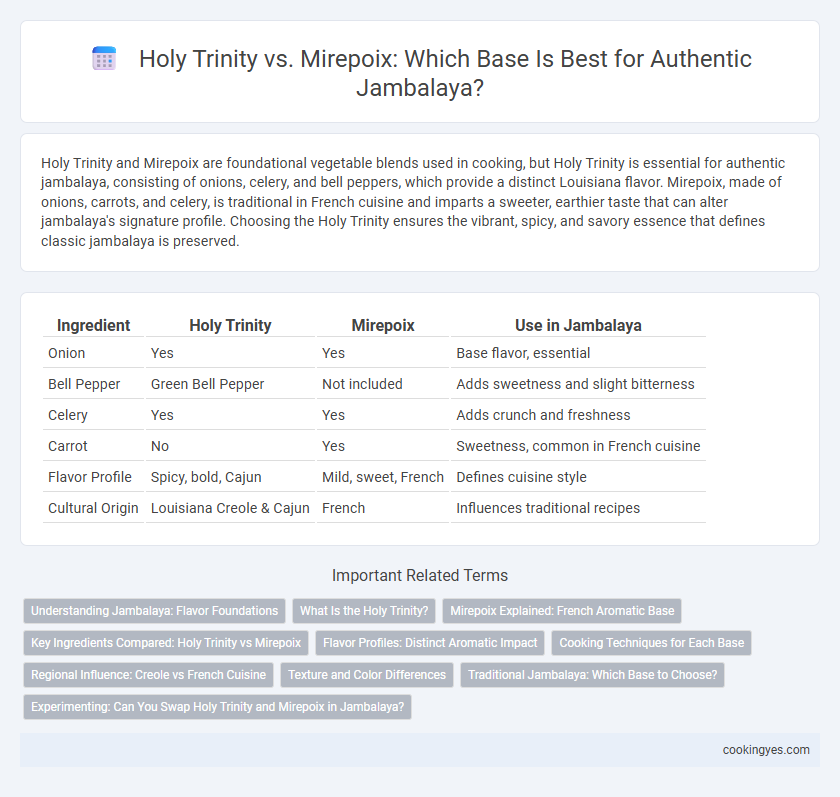Holy Trinity and Mirepoix are foundational vegetable blends used in cooking, but Holy Trinity is essential for authentic jambalaya, consisting of onions, celery, and bell peppers, which provide a distinct Louisiana flavor. Mirepoix, made of onions, carrots, and celery, is traditional in French cuisine and imparts a sweeter, earthier taste that can alter jambalaya's signature profile. Choosing the Holy Trinity ensures the vibrant, spicy, and savory essence that defines classic jambalaya is preserved.
Table of Comparison
| Ingredient | Holy Trinity | Mirepoix | Use in Jambalaya |
|---|---|---|---|
| Onion | Yes | Yes | Base flavor, essential |
| Bell Pepper | Green Bell Pepper | Not included | Adds sweetness and slight bitterness |
| Celery | Yes | Yes | Adds crunch and freshness |
| Carrot | No | Yes | Sweetness, common in French cuisine |
| Flavor Profile | Spicy, bold, Cajun | Mild, sweet, French | Defines cuisine style |
| Cultural Origin | Louisiana Creole & Cajun | French | Influences traditional recipes |
Understanding Jambalaya: Flavor Foundations
The flavor foundation of Jambalaya relies heavily on the Holy Trinity, a Cajun and Creole combination of onions, bell peppers, and celery, which provides a distinctive aromatic base crucial for authentic taste. Unlike the French mirepoix, which includes onions, carrots, and celery, the Holy Trinity omits carrots and adds bell peppers, creating a unique profile that enhances the dish's rich, spicy character. This substitution shapes the savory depth and complexity characteristic of traditional Jambalaya recipes, emphasizing Louisiana's regional culinary identity.
What Is the Holy Trinity?
The Holy Trinity in Cajun and Creole cooking consists of onions, bell peppers, and celery, forming the essential flavor base for dishes like jambalaya. This trio differs from the French mirepoix, which uses onions, carrots, and celery, offering a sweeter flavor profile less suited to traditional Louisiana cuisine. Understanding the Holy Trinity is crucial for authentic jambalaya preparation, as it provides the distinct aromatic foundation that defines the dish's regional taste.
Mirepoix Explained: French Aromatic Base
Mirepoix, a classic French aromatic base composed of onions, carrots, and celery, differs from the Holy Trinity used in Jambalaya, which substitutes bell peppers for carrots. This mirepoix blend imparts a subtly sweet and earthy flavor foundational to many French dishes, whereas the Holy Trinity adds a distinct Cajun and Creole zest. Understanding mirepoix highlights how regional variations in aromatic bases influence the signature flavors of traditional Jambalaya recipes.
Key Ingredients Compared: Holy Trinity vs Mirepoix
Jambalaya relies on the Holy Trinity--onions, celery, and bell peppers--as its foundational flavor base, distinguishing it from the French mirepoix of onions, carrots, and celery. The substitution of bell peppers for carrots introduces a slightly sweet, earthy note essential to Creole and Cajun cuisine. This key ingredient variation defines jambalaya's distinctive taste profile and authentic regional character.
Flavor Profiles: Distinct Aromatic Impact
The Holy Trinity of Cajun and Creole cooking--onions, bell peppers, and celery--delivers a vibrant, slightly sweet, and earthy flavor that forms the authentic base of jambalaya. Mirepoix, traditionally composed of onions, carrots, and celery, imparts a milder sweetness and a subtly sweet, less pronounced pepper note that suits French cuisine but lacks the bold aromatic punch of the Holy Trinity. This distinct aromatic impact from the Holy Trinity enhances jambalaya's signature robust, smoky, and spicy flavor profile, making it essential for true Southern Louisiana dishes.
Cooking Techniques for Each Base
The Holy Trinity--celery, bell peppers, and onions--is sauteed slowly in oil or fat to develop deep, aromatic flavors essential for authentic jambalaya. Mirepoix, composed of onions, carrots, and celery, requires a lighter saute to maintain sweetness and subtlety, often used in French cooking rather than Creole dishes. Mastering the heat and timing during sauteing ensures the base enhances the jambalaya's overall complexity without overpowering the other ingredients.
Regional Influence: Creole vs French Cuisine
The Holy Trinity, consisting of bell peppers, onions, and celery, is fundamental to Creole cuisine and defines the distinct flavor profile of Jambalaya in Louisiana, emphasizing bold and spicy notes. Mirepoix, a classic French base of onions, carrots, and celery, reflects the French culinary influence but is less suited for authentic Jambalaya due to its sweeter, more subdued flavor. The regional influence highlights Creole cooking's adaptation of French techniques with New World ingredients, making the Holy Trinity essential for capturing the dish's original essence.
Texture and Color Differences
The Holy Trinity, consisting of bell peppers, onions, and celery, provides a vibrant color contrast and a crisp texture essential to authentic Jambalaya, enhancing its visual appeal and mouthfeel. Mirepoix, made from onions, carrots, and celery, introduces a sweeter flavor with softer textures and a more muted color palette, which can dull the dish's characteristic boldness. Choosing the Holy Trinity over Mirepoix preserves the traditional bright, aromatic profile and distinct crunchy texture that define classic Cajun and Creole Jambalaya.
Traditional Jambalaya: Which Base to Choose?
Traditional jambalaya relies heavily on the Holy Trinity--celery, bell peppers, and onions--as its essential flavor base, distinguishing it from mirepoix, which uses carrots instead of bell peppers. The Holy Trinity provides a unique, authentic taste profile that complements Cajun and Creole spices integral to jambalaya recipes. Choosing the Holy Trinity preserves the cultural heritage and bold, savory depth characteristic of classic jambalaya dishes.
Experimenting: Can You Swap Holy Trinity and Mirepoix in Jambalaya?
Swapping the Holy Trinity (onion, bell pepper, celery) with Mirepoix (onion, carrot, celery) in jambalaya alters the dish's traditional flavor profile by introducing the sweetness of carrots instead of the slightly bitter pepper. Experimenting with this substitution affects the balance of savory and aromatic notes, potentially creating a milder, sweeter jambalaya. Culinary enthusiasts aiming to customize jambalaya can test this swap to explore diverse taste outcomes while maintaining the dish's essential aromatic base.
Holy Trinity vs Mirepoix for Jambalaya Infographic

 cookingyes.com
cookingyes.com